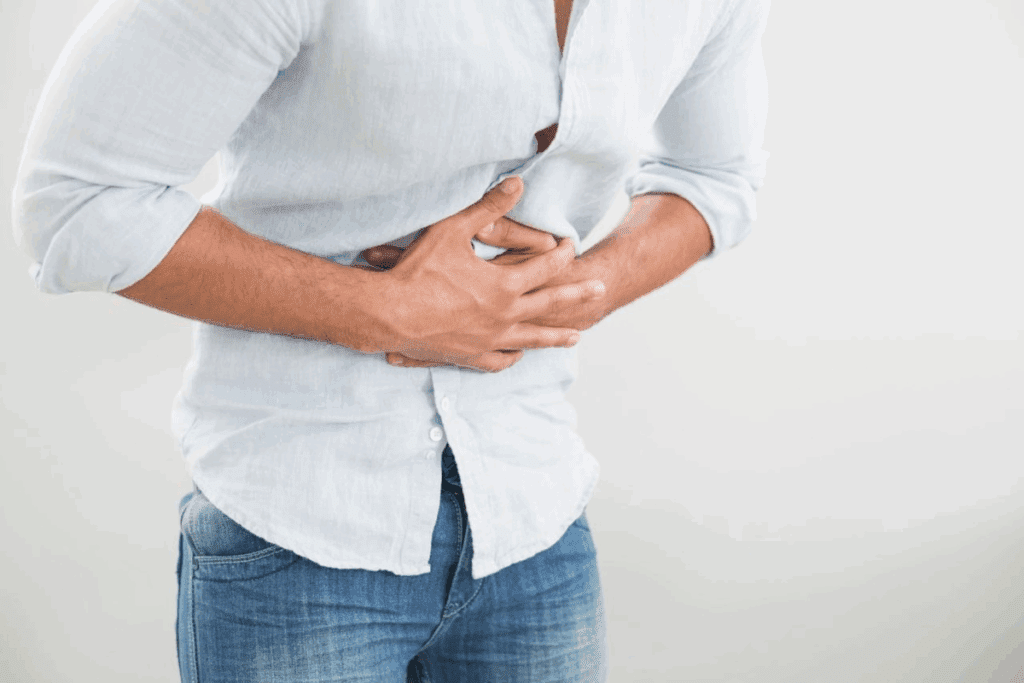Last Updated on November 26, 2025 by Bilal Hasdemir

The gallbladder is a small, pear-shaped pouch under the liver. It stores and concentrates bile before it goes into the small intestine for digestion.
It’s important to know the signs of a bad gallbladder to get medical help early. Common symptoms include sudden or ongoing pain in the upper right abdomen. This pain might also spread to the back or right shoulder.
How can you tell if you have gallbladder issues? Learn 8 bad signs and key symptoms of a failing gallbladder that you shouldn’t ignore.
Ignoring these symptoms can cause serious health issues. Liv Hospital focuses on patient care and high medical standards. Knowing the key symptoms of a malfunctioning gallbladder is vital.

The gallbladder is a small but vital organ in our digestive system. It sits under the liver and stores bile. This bile is made by the liver and helps digest fats in the small intestine.
The gallbladder’s main job is to hold bile. This yellow-green fluid is made by the liver. When we eat fatty foods, the gallbladder releases bile into the small intestine. This bile helps break down fats and vitamins.
There are several conditions that can affect the gallbladder. These can cause different symptoms and problems. Some common ones include:
| Condition | Description | Common Symptoms |
| Gallstones | Hard deposits in the gallbladder | Abdominal pain, nausea, vomiting |
| Cholecystitis | Inflammation of the gallbladder | Severe abdominal pain, fever, jaundice |
| Biliary Dyskinesia | Poor gallbladder function | Digestive issues, abdominal pain |
Finding gallbladder problems early is key to avoiding serious issues. If left untreated, gallbladder problems can cause severe pain, infection, and even life-threatening conditions. Spotting symptoms early can help get medical help quickly. This can lower the risk of serious problems and improve health outcomes.
Key Takeaway: Knowing how your gallbladder works and the common issues it faces is vital. It helps keep your digestive system healthy and prevents serious problems.

Gallbladder problems often show up as abdominal pain. This is a sign that you should pay attention to. Knowing what this pain feels like can help you tell it apart from other kinds of stomach pain.
Gallbladder pain feels sharp, stabbing, or cramping. It usually happens in the upper right part of your belly. This pain can be very strong and might spread to your back or right shoulder.
It often starts after eating fatty foods. You might feel it at any time, but it’s more likely after you’ve eaten.
Key Features of Gallbladder Pain:
It’s important to tell gallbladder pain apart from other kinds of stomach pain. Gallbladder pain is usually more intense. It might also come with nausea or vomiting.
| Characteristics | Gallbladder Pain | Other Abdominal Pain |
| Location | Upper right abdomen | Varies (e.g., lower abdomen for appendicitis) |
| Intensity | Sharp, stabbing, or cramping | Mild to severe, varies |
| Triggers | Fatty meals | Varies (e.g., food intolerance, stress) |
The timing and how long gallbladder pain lasts can give you clues. It usually lasts from 15 minutes to several hours. It often starts after eating, and fatty meals are a common trigger.
Spotting the signs of gallbladder problems, like stomach pain, is key to catching them early. If you’re having ongoing or severe stomach pain, see a doctor. They can help figure out what’s wrong and how to treat it.
Feeling pain that radiates to your back or right shoulder can be a sign of gallbladder trouble. This pain is a common symptom of gallbladder issues. Knowing why it happens can help spot problems early.
The pain spreads because the gallbladder and back or shoulder share nerve roots. When the gallbladder gets inflamed or irritated, it can send pain signals to these areas.
Shared Nerve Roots: The gallbladder and back or shoulder have common nerve roots. Problems with the gallbladder, like inflammation or gallstones, can irritate these nerves. This causes pain to spread to other areas.
Referred pain from the gallbladder has specific traits. It often happens after eating fatty meals. It can also come with nausea or vomiting.
Characteristics of Referred Pain:
Shoulder pain can sometimes mean a gallbladder emergency, like a gallbladder attack or cholecystitis. Severe, ongoing pain or symptoms like fever or jaundice need immediate medical help.
Recognizing a Gallbladder Emergency:
Gallbladder problems often show up as nausea and vomiting. The gallbladder helps digest fats by releasing bile into the small intestine. If it doesn’t work right, you might feel sick to your stomach.
The gallbladder stores bile from the liver. Bile breaks down fats so they can be digested in the small intestine. If the gallbladder doesn’t work, you might not digest fats well, leading to stomach problems.
Key aspects of gallbladder function in digestion include:
Nausea and vomiting are signs of gallbladder trouble. These symptoms happen when the gallbladder can’t release bile properly. They often get worse after eating fatty foods.
Common patterns include:
Chronic indigestion can signal gallbladder problems. It’s a long-term pain or discomfort in the upper stomach. It often happens after eating, and fatty meals make it worse.
Characteristics of chronic indigestion related to gallbladder issues:
When the gallbladder doesn’t work right, you might notice changes in your stool and bowel habits. These changes can be small but mean you should see a doctor.
One big sign of gallbladder trouble is different stool colors. Light-colored or clay-colored stools mean there’s not enough bile. Bile helps digest fats and absorb vitamins. Without enough bile, your stools can look pale or clay-like.
Diarrhea after eating fatty foods can also point to gallbladder problems. The gallbladder helps break down fats. If it’s not working, you might get diarrhea. This symptom shows how important the gallbladder is for digestion.
Some people might get constipation or other bowel changes instead. These can include changes in how often you go, how your stool looks, or finding undigested food in your stool. These signs mean your gallbladder might not be working right.
In short, changes in your bowel habits and stool are important signs. If you notice them often or they’re bad, see a doctor. They can find out why and help you get better.
It’s important to know how fever and chills relate to gallbladder health. These symptoms can mean your gallbladder is infected or inflamed. This is a serious issue that needs quick attention.
A fever might mean your gallbladder is infected. This is called cholecystitis. It happens when gallstones block the cystic duct, causing inflammation. This can be very dangerous if not treated right away.
Key signs that fever indicates gallbladder infection include:
Distinguishing between cholecystitis and cholelithiasis is key. Both affect the gallbladder but differently. Their symptoms and risks vary.
| Condition | Primary Symptoms | Complications |
| Cholelithiasis | Intermittent pain, often after fatty meals | Gallstone obstruction, potentially leading to cholecystitis |
| Cholecystitis | Severe pain, fever, nausea | Infection spread, gangrene, perforation |
Watching for temperature changes is critical if you think you have gallbladder issues. A high temperature can signal infection or inflammation early on.
Tips for monitoring temperature:
Jaundice makes the skin and eyes turn yellow. It’s a sign of gallbladder problems. This happens when bilirubin builds up in the body, often because of a bile duct blockage.
A bile duct blockage stops bile from flowing from the liver to the small intestine. This blockage causes bilirubin to build up, leading to jaundice. It can be caused by gallstones, tumors, or inflammation.
Common causes of bile duct blockage include:
Jaundice shows up as yellow skin and eyes, fatigue, and loss of appetite. Catching these symptoms early is key to getting medical help on time.
Key symptoms to watch out for:
Dark urine is an early sign of jaundice and bile duct blockage. When bilirubin builds up, urine turns yellow or amber.
Monitoring urine color can be a simple yet effective way to detect gallbladder issues early. If your urine color keeps changing, see a doctor for a check-up.
Knowing when to get medical help for gallbladder symptoms is very important. The gallbladder is small but plays a big role in digestion. If it doesn’t work right, it can cause serious problems.
Gallbladder issues can show up in different ways. Some symptoms are very serious and need quick medical help. It’s key to know these signs to stop the problem from getting worse.
Some symptoms mean you need to see a doctor right away. These include:
If you or someone you know has these symptoms, get medical help fast. Waiting too long can cause serious problems, like a ruptured gallbladder or infection.
When gallbladder issues are thought of, doctors use several tests to find out what’s wrong. These tests are:
These tests are very important. They help doctors find out what’s causing the symptoms and decide the best treatment.
Treatment for gallbladder problems depends on what’s found. For gallstones or chronic disease, surgical removal of the gallbladder (cholecystectomy) is often needed. This can be done laparoscopically or through open surgery.
For acute cholecystitis or infections, treatment might include:
In some cases, medicine to dissolve gallstones might be used. But surgery is usually more effective.
Knowing about treatment options and what to expect can help. It makes patients feel more at ease and ensures they get the right care for their gallbladder issues.
It’s important to know the signs of gallbladder issues to stay healthy. By recognizing these signs, you can prevent serious problems and get help when needed.
Eating right, drinking plenty of water, and keeping a healthy weight are key. These habits help avoid gallbladder diseases.
Being proactive about your health is vital. Knowing the risks and taking steps to prevent them helps keep your gallbladder and overall health in check.
Preventing gallbladder disease is all about staying healthy. By focusing on gallbladder health, you can avoid surgery and live better.
Signs of a bad gallbladder include pain in the abdomen, often after eating fatty foods. You might also feel nauseous, vomit, or notice changes in your bowel movements or stool color.
Problems with the gallbladder can show as pain in the abdomen. This pain might spread to the back or right shoulder. You might also feel sick to your stomach, have changes in bowel habits, fever, or jaundice.
If you’re feeling persistent pain in your abdomen, are nauseous, or have changes in your bowel habits, see a doctor. They can help figure out what’s wrong and how to treat it.
A malfunctioning gallbladder can lead to chronic indigestion. You might also have diarrhea after eating fatty foods, constipation, or notice your stools are light-colored or clay-like.
Yes, a bad gallbladder can cause pain that radiates to the back or right shoulder. This is because of how pain signals are sent from the gallbladder to the brain.
If you’re feeling nauseous and have pain in your abdomen, it could be related to your gallbladder. This is more likely if the pain happens after eating fatty meals or if you’re vomiting.
Emergency signs include severe pain in your abdomen, a high fever, jaundice, and dark urine. These symptoms need immediate medical help.
Doctors use tests like ultrasound, CT scans, and blood tests to diagnose gallbladder problems. These tests help check for signs of infection or inflammation.
Treatment options include surgery to remove the gallbladder, medications to dissolve gallstones, or other methods to manage symptoms. These help prevent further complications.
Yes, you can digest food without a gallbladder. But, you might need to make some changes to your diet. This can help manage symptoms and prevent digestive problems.
Subscribe to our e-newsletter to stay informed about the latest innovations in the world of health and exclusive offers!